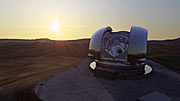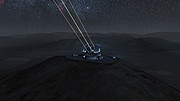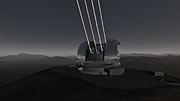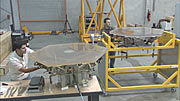Lehdistötiedote
E-ELT siirtyy lähemmäs toteutumistaan
9. joulukuuta 2011
Euroopan eteläisen observatorion hallintoelin, ESO:n neuvosto on hyväksynyt ESO:n budjetin vuodelle 2012. Se sisältää E-ELT:n sijaintipaikalle Cerro Armazonesille johtavan tien valmistelevan työn ja joidenkin teleskoopin erityisen haastavien optisten komponenttien kehitystyön aloittamisen. Nyt kun useat ESO:n jäsenmaat ovat osaltaan sitoutuneet vaadittavaan lisärahoitukseen, koko E-ELT -ohjelman lopullista hyväksyntää odotetaan vuoden 2012 puolivälin tienoilla.
ESO:n neuvosto hyväksyi vuoden 2012 budjetin 124. kokouksessaan ESO:n päämajassa 7.-8. joulukuuta 2011. Budjetti sisältää rahoituksen joillekin E-ELT:n ensimmäisistä rahoituskohteista. Nämä käsittävät teleskoopin sijaintipaikalle Cerro Armazonesille johtavien yhteysteiden rakentamista valmistelevan työn ja haastavan, adaptiivisen optiikan peilin työstämisen aloittamisen. Kyseinen peili on M4, eli teleskoopin viidestä peilistä neljäs. Työ aloitetaan varhain vuonna 2012. Koko E-ELT -projektin lopullista hyväksyntää odotetaan vuoden 2012 puolivälin tienoilla.
Viimeisten muutaman kuukauden aikana E-ELT -projekti on edennyt vauhdilla. Sopimus ESO:n ja Chilen hallituksen välillä allekirjoitettiin lokakuussa 2011. Se sisältää Chilen hallituksen tuen E-ELT -projektille ja maa-alueen lahjoittamisen teleskooppia varten (eso1139). Lokakuussa 2011 ulkopuolinen arviointi vahvisti, että E-ELT voidaan rakentaa esitetyn 1082 miljoonan euron (vuoden 2012 euroina) budjetin puitteissa.
Aikaisemmat yksityiskohtaiset arvioinnit ovat jo vahvistaneet, että rakenne on teknisesti luotettava. Syyskuun 2011 kokouksessa ESO:n tieteellistekninen komitea (STC) kannatti suunnitelmaa, joka kuvailee ensimmäisten E-ELT:hen liitettävien instrumenttien ulottuvuuksia ja niiden kehitystyön aikataulua.
Yksityiskohtainen E-ELT:n rakennusesitys, kokonaisvaltainen 264-sivuinen projektin kaikki näkökulmat kattava kirja, ja toimeenpanoyhteenveto ovat nyt saatavilla.
Kaikki ESO:n jäsenmaat ovat valmiit aloittamaan E-ELT -projektin ja ovat yksimielisesti sopineet kuinka valtavan projektin lisäkustannukset jaetaan. Kolme ESO:n jäsenmaata: Tšekin tasavalta, Ruotsi ja Suomi, ovat jo sitoutuneet lisärahoitukseen. Useat muut jäsenmaat, mukaanlukien ESO:n suurin jäsenmaa, Saksa, ovat myös ilmoittaneet, että ne ovat nyt valmiit tukemaan projektia taloudellisesti. Jäsenmaiden riittävän rahoituksen odotetaan olevan hyväksytty vuoden 2012 puoliväliin mennessä, mikä mahdollistaa tuolloin neuvoston täyden hyväksynnän E-ELT -projektille [1]. Tämä aikataulu olettaa, että Brasilia on saattanut loppuun ESO-jäsenyytensä ratifioinnin siihen mennessä.
"E-ELT alkaa muuttua todellisuudeksi. Tämänkokoisen projektin lisärahoituksen vaatiman hyväksynnän voi kuitenkin olettaa vievän aikaa. Neuvosto tunnustaa samaan aikaan, että valmistelevan työn täytyy alkaa nyt, jotta projekti on valmis rakennustöiden täyteen käynnistämiseen vuonna 2012," sanoo ESO:n pääjohtaja Tim de Zeeuw.
Viime aikoina on myös tehty joitakin merkittäviä kansallisten rahoitusten sitoutumisia teleskoopille ja sen havaintolaitteille (ann11067).
Muiden kokouksen edistysaskelten joukossa ESO:n neuvosto valitsi yksimielisesti espanjalaisen professori Xavier Barconsin seuraavaksi neuvoston puheenjohtajaksi ja hyväksyi E-ELT:n projektipäällikön nimittämisen. Tähän virkaan haetaan ehdokkaita par'aikaa.
E-ELT on suurin ESO:n milloinkaan aloittama projekti ja suurin maanpäällinen optisen ja infrapunatähtitieteen projekti kautta aikojen. E-ELT:n odotetaan aloittavan toimintansa ensi vuosikymmenen alkupuolella.
Lisähuomiot
[1] Neuvosto on sopinut, että projekti voidaan hyväksyä täysin ennen kuin 100% jäsenmaiden lisärahoituksesta on varmistunut.
Lisätietoa
ESO, Euroopan eteläinen observatorio, on Euroopan johtava hallitustenvälinen tähtitieteen organisaatio ja maailman tieteellisesti tuotteliain tähtitieteellinen observatorio. ESO:lla on 15 jäsenmaata: Alankomaat, Belgia, Brasilia, Espanja, Iso-Britannia, Italia, Itävalta, Portugali, Ranska, Ruotsi, Saksa, Suomi, Sveitsi, Tanska ja Tšekin tasavalta. ESO toteuttaa kunnianhimoista ohjelmaa, joka keskittyy tehokkaiden maanpäällisten havaintovälineiden suunnitteluun, rakentamiseen ja käyttöön. Välineiden avulla tähtitieteilijät voivat tehdä merkittäviä tieteellisiä löytöjä. ESO:lla on myös johtava asema tähtitieteen tutkimuksen kansainvälisen yhteistyön edistämisessä ja organisoinnissa. ESO:lla on Chilessä kolme ainutlaatuista huippuluokan observatoriota: La Silla, Paranal ja Chajnantor. ESO:lla on Paranalilla Very Large Telescope (VLT), maailman kehittynein näkyvää valoa havainnoiva tähtitieteellinen observatorio, ja kaksi kartoitusteleskooppia. VISTA toimii infrapuna-alueella ja on maailman suurin kartoitusteleskooppi. VLT Survey Telescope on suurin vartavasten taivaan näkyvän valon kartoitukseen suunniteltu teleskooppi. ESO on maailman suurimman tähtitieteellisen projektin, vallankumouksellisen ALMA-teleskoopin eurooppalainen yhteistyökumppani. Parhaillaan ESO suunnittelee 40-metrin kokoluokan optisen/lähi-infrapuna-alueen European Extremely Large -teleskooppia (E-ELT) josta tulee “maailman suurin tähtitaivasta havainnoiva silmä”.
Linkit
- E-ELT Construction Proposal Executive Summary and Proposal Digest
- E-ELT Construction Proposal book
- E-ELT:n sivut
Yhteystiedot
Rami Rekola
Tuorlan observatorio
Piikkiö, Finland
Puh.: +358 2 333 8981
Matkapuhelin: +358 44 967 2424
Sähköposti: rareko@utu.fi
Lars Lindberg Christensen
Head, ESO education and Public Outreach Department
Garching bei München, Germany
Puh.: +49 89 3200 6761
Matkapuhelin: +49 173 3872 621
Sähköposti: lars@eso.org
Richard Hook
ESO, La Silla, Paranal, E-ELT & Survey Telescopes Press Officer
Garching bei München, Germany
Puh.: +49 89 3200 6655
Matkapuhelin: +49 151 1537 3591
Sähköposti: rhook@eso.org
Tiedotteesta
| Tiedote nr.: | eso1150fi |
| Nimi: | Cerro Armazones, Extremely Large Telescope |
| Tyyppi: | Unspecified : Technology : Observatory : Telescope |
| Facility: | Extremely Large Telescope |







